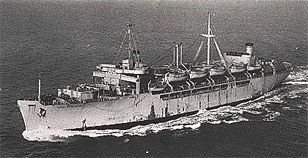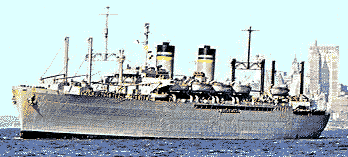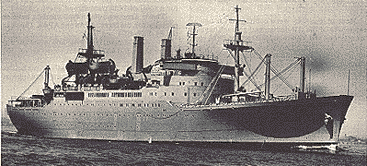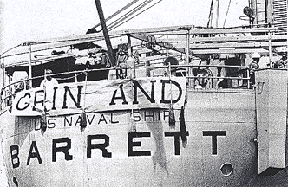Military Sealift Command Ships of the Line
By Salvatore R. Mercogliano
In 1973, with the withdrawal of American forces from Vietnam, the last two troop transports - the third arm of the early military sealift triad, the other two being freighters and tankers - were removed from active service, ending the regularly scheduled operations of these ships. This event marked the true transition point from Military Sea Transportation Service to the modern Military Sealift Command. The initial fleet of troopers consisted of a mixture of several different classes but three primary ones emerged: the C-4 General-class, and the larger and more prestigious, hence better paying, P-2 Admiral and General-classes.
C-4 Troopships
The C-4s had a long and varied service with MSTS. Initially conceived as a vehicle carrier, similar to the successful Seatrain type vessels, the urgent need to deploy troops overseas and concerns over losses to the ships due to lack of adequate watertight protection, led to their conversion into troop transports. At 532 feet in length, and 12,420 gross tons, they were some of the largest vessels built by the Maritime Commission during the Second World War. They could accommodate 228 officers, 3,595 men, and 6,840 tons of cargo, with a cruising speed of 17 knots. Unlike Navy Attack Transports, troopers lacked the watercraft necessary to transfer their charges ashore and were intended for use in point-to-point operations.
Both the Army and the War Shipping Administration utilized this class of ship and when the Army Transport Service was transferred to MSTS in March 1950, 23 C-4s were redesignated as United States Naval Ships, with 6 others reactivated for the Korean War.
One of these ships, USNS General R. M. Blatchford, had an extraordinary career with MSTS. Launched in late 1944 from the Kaiser Shipbuilding Company of Richmond, California, she sailed in both the Pacific and Atlantic before the conclusion of hostilities. During the Korean War, in one 201-day period, Blatchford sailed the equivalent of twice around the world, visited 17 different ports, and embarked over 18,000 soldiers from the United States, the Netherlands, Belgium, Greece, Turkey, France, and Ethiopia. After the war, the ship resumed scheduled runs between the United States and overseas bases for the periodic rotation of troops.
USNS General R. M. Blatchford C4-S-A1 troopshipThe advent of jet airliners, and the decision to utilize berthing spaces on board U.S.-flagged passenger ships led to the deactivation of the remaining C-4s in 1958. A request by the United Nations to support the deployment of an international force to the Congo led to its recall. Nicknamed the "Ambassador Ship," from February 1961 to July 1963, Blatchford transported a total of 43,500 troops from Malaysia, India, Ethiopia, Indonesia, Pakistan, Morocco, and even Iraq, over a total of 227,000 miles.
Upon her return to New York, Secretary General U Thant stated, "I should appreciate if you would convey to your Government my gratitude for making the USNS Blatchford available to the United Nations, and in particular, if you would inform the officers and men of the USNS Blatchford of our appreciation for the cooperation and sense of duty which characterized their service." In 1970, as part of a ship exchange program, she was sold to Waterman Steamship Company for conversion into a breakbulk/container ship, SS Stonewall Jackson, and served for ten years till scrapped in Taiwan.
The other major classes of transports were born out of a conscious decision by the senior American military and maritime leaders not to produce ships similar in size to the British Queen Mary and Queen Elizabeth, or the French Normandie. The initial building plan of the U.S. Maritime Commission had as its flagship the liner SS America, but is was only a pale comparison to her larger and faster European cousins. She was the only passenger vessel envisioned in the original 500-ship program.
P-2 Troopships
Following the attack on Pearl Harbor, one of the greatest difficulties the US faced was the transportation of forces to multiple theaters. The Commission formulated plans for a series of medium size troopers, the P-2s. A total of 21 ships were constructed, with those on the East Coast having a distinctive clipper bow, two pole masts, a pair of large racked stacks, and named for Army Generals. The 10 built on the West Coast, appeared more business-like in appearance, with squat stacks, kingposts in place of masts, and named for Admirals.
Following the war, the Naval Transportation Service retained 6 of the Generals for use in the Pacific, while the remaining ships, except for three transferred to commercial companies, went to the Army, who subsequently dropped their naval names and renamed them for their own flag officers.
USNS General Maurice Rose (former Admiral Hugh Rodman) P2-SE2-R1MSTS Troopships
MSTS fielded an impressive force of troopers, a total of 53 ships with the capability to transport over 175,000 troops in a single lift. The outbreak of war in Korea in June 1950 revealed that although these figures may have been adequate for peacetime, they were unable to handle the deployment of forces not only to Korea, but also to Europe to sustain the U.S. commitment to the newly formed North Atlantic Treaty Organization (NATO).
The shipment of combatant forces proved so critical, that on August 29, 1950, Department of Defense requested permission from the Maritime Administration to impress six passenger vessels under construction. By November, the situation in Korea temporarily subsided and the proposed USNS Constitution, Independence, and United States never sailed under MSTS colors.
The service did continue with the conversion of three American President Line ships. Renamed for Marine Corps generals - USNS Barrett, Geiger, and Upshur - they had two large holds forward and aft, and staterooms for 400 officers and bunks for 1,500 troops amidships. The most revolutionary feature on the ships was the installation of air-conditioning. Included in its original civilian specifications, this feature made the ships a favorite of troops and crews alike.
P2 Troopship USNS GeigerAlso, unlike the P-2s, they were fitted with only one screw and a single-engine room, while a liability in time of war, it made the ships more economical to operate over the long run and a major contributing factor to their longevity.
To command the lead ship in the class, Vice Admiral William M. Callaghan selected perhaps the best known master in MSTS at that time, Captain Kenneth G. Towne. As the master of the SS Seatrain Texas in the Second World War, he shuttled the initial tanks of the Army's 1st Armored Division from the U.S. to the United Kingdom in early 1942.
In that summer, with German General Erwin Rommel pushing the British Eighth Army back toward the crucial Suez Canal, Chief of Staff of the U.S. Army General George C. Marshall offered them the use of the 2nd Armored Division. In desperate need of replacement tanks and material, the British asked that the Americans ship them to Egypt via the Cape of Good Hope, to avoid German aircraft and U-boats in the contested Mediterranean Sea.
In July 1942, Convoy AS-4 departed from New York with six ships but a submarine sank SS Fairport of Waterman Steamship Company, loaded with tanks. Marshall hurriedly made an additional 250 tanks available and SS Seatrain Texas sailed the end of the month, without an escort, to catch up with the convoy. She completed the voyage in one month and five days and her cargo proved crucial to the Allied victory at El Alamein.
In December 1951, Towne took command of USNS Barrett and both the ship and captain proved themselves when they came to the assistance of the freighter SS President Pierce, rocked by flames and explosions in one of its holds.
Troopships in Korea, Vietnam and Somalia
The Korean War symbolized the vital need of troop transports, six out of every seven persons sent there went by sea. By 1952, MSTS operated 69 troopships, but with the end of the conflict, the stabilization of forces in Europe, and the increased use of commercial passenger ships and jet airliners, the fleet began to diminish in size. By the time of the Vietnam War, only the P-2s and the three ex-APL transports remained in service. When President Lyndon Johnson decided to deploy the 1st Cavalry (Airmobile) Division to Southeast Asia, MSTS diverted USNS Upshur, Geiger, Darby, Buckner, Rose, and Patch from their regularly scheduled Atlantic runs and embarked their new charges in Charleston and Savannah. Although the ships returned to their routes, it proved short-lived with their permanent transfer to the Pacific in 1966, ending MSTS regularly scheduled runs to Europe.
On June 8, 1968, USNS Barrett departed from Tacoma, Washington for Vietnam, marking the last scheduled military ocean passengers service from the continental United States. Two of the three ex-APL ships continued to operate, shuttling Korean forces between their nation and Vietnam. In April 1973, with the cease-fire in place, these ships were withdrawn from service with all three of the class becoming training vessels for the State Maritime Academies in Massachusetts, Maine, and New York.
"Grin and Barrett" as the USNS Barrett makes its final voyage as a troopshipOver their twenty-five year history of continuous operations, MSTS troopers carried 17,682,768 men, women, and children. From soldiers going into battle in Korea and Vietnam, to those manning defensive positions along the Fulda Gap in Germany, to dependents moving to be near their loved ones, to refugees fleeing from oppressive governments, the successes of the troop transports are not forgotten.
On January 3, 1994, the SS Empire State VI, the school ship for the State University of New York Maritime College, was activated from the Ready Reserve Force to support the withdrawal of American forces from Mogadishu, Somalia. The military feared the loss of a fully loaded jet airliner and instead planned to sealift the troops to Mombassa, Kenya, from where they were airlifted home. While the deployment only lasted three months, the ship, under the command of Captain Scott James, once again demonstrated the unique capability that American merchant shipping, in particular passenger vessels, provide this nation.
Illustrations from:
From America to United States: The History of the long-range Merchant shipbuilding Programme of the Unites States Maritime Commission (1937-1952) Part 2, L.A. Sawyer and W.H.Mitchell London: World Ship Society, 1981
Personal collection
Military Sea Transportation Service, NAVPERS 10829-B, bureau of Naval Personnel, Washington, DC: U.S. Government Printing Office, 1962
Sealift, March 1973, Military Sea Transportation Service, U.S. Government Printing Office
www.USMM.org is grateful to Professor Salvatore R. Mercogliano for providing this article. Mercogliano is writing his doctoral dissertation about the history of the Merchant Marine, Military Sea Transportation Service and Military Sealift Command.Continue to: MSTS and MSC Operations Other Than War by Salvatore R. Mercogliano
Continue to: MSC Ships that Wait by Salvatore R. Mercogliano
Home11/29/00
www.USMM.org ©1998, 1999, 2000 Salvatore R. Mercogliano and. You may quote material on this web page as long as you cite American Merchant Marine at War, www.usmm.org, as the source. You may not use more than a few lines without permission. If you see substantial portions of this page on the Internet or in published material please notify usmm.org @ comcast.net



